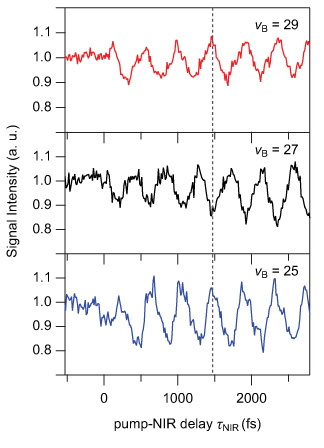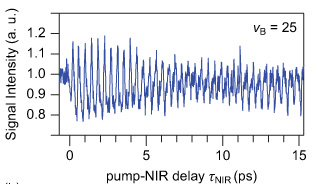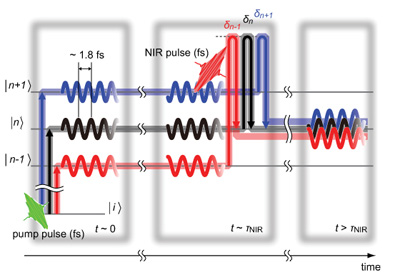
In quantum mechanics different eigenstates are orthogonal and do not interfere with each other. Kenji Ohmori at the Institute for Molecular Science in Okazaki, Japan, and his colleagues have discovered unusual interference among multiple quantum waves in different eigenstates induced actively and moreover controlled with a strong femtosecond laser pulse.
Molecules are expected to be promising components to develop scalable quantum computers. A number of theoretical proposals have been made for the logic gates with molecular eigenstates superposed coherently whose populations are redistributed with a strong femtosecond (fs) laser pulse. It is not yet observed experimentally, however, how each eigenstate changes its population in the strong laser field. Here we demonstrate direct observation of the population change of each eigenstate within a molecular wave-packet (WP) modulated by a strong non-resonant fs laser pulse in the near-infrared (NIR) region. The population of each eigenstate shows a clear beat as a function of the delay of the NIR pulse with a period close to the recurrence period of the WP motion (see Fig. 1), even though a single eigenstate within a WP should have no information on the position and motion of the WP.
Moreover the beat shows an unexpected feature similar to the collapse and revival of a WP (see Fig. 2), which should appear only when three or more eigenstates are superposed. This unusual beat and its collapse and revival seen in a single eigenstate are elucidated in terms of quantum interference induced by the NIR pulse among multiple eigenstates optically combined on a single eigenstate (see Fig. 3).
This new concept, which we refer to as “strong-laser-induced interference” is not specific to the molecular eigenstates, but universal to any type of eigenstates of a variety of quantum systems, being a new tool for quantum logic gates, and providing a new option to manipulate WPs with fs laser pulses in general applications of coherent control.
 Figure 1. Quantum beat observed in a single eigenstate modulated with the strong near-infrared (NIR) laser pulse. The populations of the eigenstates v_{B} = 25, 27, and 29 of the B electronic state of the iodine molecule show clear beats as functions of the delay of the NIR pulse scanned on the femtosecond time scale.
Figure 1. Quantum beat observed in a single eigenstate modulated with the strong near-infrared (NIR) laser pulse. The populations of the eigenstates v_{B} = 25, 27, and 29 of the B electronic state of the iodine molecule show clear beats as functions of the delay of the NIR pulse scanned on the femtosecond time scale.

Figure 2. Collapse and revival of the quantum beat observed in a single eigenstate v_{B}= 25 of the B electronic state of the iodine molecule modulated with the strong near-infrared (NIR) laser pulse as a function of the NIR-pulse delay scanned for a longer period than that of Fig. 1.

Figure 3. Schematic of the strong-laser-induced interference (SLI).
Starting from a common initial state |i> , there are multiple quantum- mechanical pathways |i> → |n -1>→ |n> , |i> → |n> → |n> , and |i> → |n +1> → |n> , indicated by red, black, and blue solid lines, respectively, to the common final state |n> . Those multiple pathways interfere quantum- mechanically with each other. The amounts of phase shifts during the strong near-infrared laser pulse are indicated as δ_ {n-1}, δ_{n}, and δ_{n+1}.
Paper Information
Journal: Nature Physics
Published online: 10 April 2011 | doi:10.1038/nphys1960
Title: Strong-Laser-Induced Quantum Interference
Authors: Haruka Goto, Hiroyuki Katsuki, Heide Ibrahim, Hisashi Chiba, Kenji Ohmori
http://www.nature.com/nphys/journal/vaop/ncurrent/full/nphys1960.html
Related Information
News and Views(doi:10.1038/nphys1979)
OHMORI Group Information
http://www.ims.ac.jp/english/know_en/photo/ohmori/ohmori_en.html
http://groups.ims.ac.jp/organization/ohmori_g/index-e.html
1110



